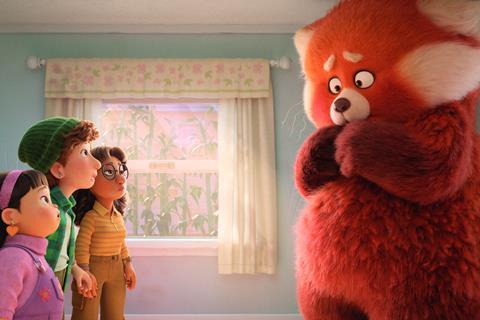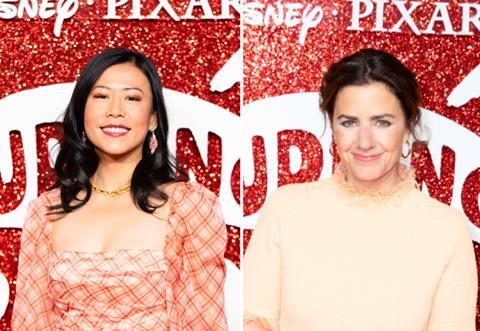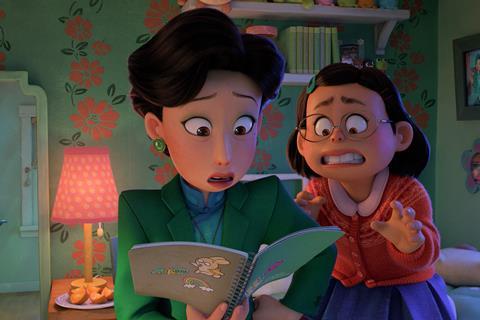Writer/director Domee Shi, writer Julia Cho and producer Lindsey Collins tell Screen about the boundary-pushing themes of Pixar’s Turning Red and their hopes that the frank teen-girl tale will bring lasting change.

After the 2019 Oscar-winning success of her debut short Bao, filmmaker Domee Shi found herself in the position of being asked to pitch feature ideas to the senior Pixar development team, including chief creative officer Pete Docter and producer Lindsey Collins. When the executives couldn’t decide which of her pitches to greenlight, Shi was called back and asked which she wanted to do. The choice was simple — it had to be Turning Red.
“I pitched it like: ‘It’s a Chinese-Canadian girl who goes through a magical puberty and transforms into a giant red panda; when she gets emotional, worked up, horny, she’s like the Incredible Hulk… but cuter,’” laughs Shi. “I had never seen a movie that really detailed how awkward, weird and embarrassing puberty is, especially for girls. And I wanted to make that movie for the 13-year-old me who was locked in her bathroom, wondering, ‘Am I dying?’”
Producer Collins (Finding Dory) says that she could feel Shi’s connection to the project, and its potential, from the beginning. “The characters of Meilin and Ming popped off the page from the start,” she says respectively of the film’s 13-year-old protagonist, who is shocked to discover that she turns into a giant panda whenever she feels any big emotion, and her overprotective mother, who is determined to keep her daughter safe. “The excitement of being able to work with [Shi] to get this to the screen was too good to pass up.”
Set in Toronto in the early 2000s — a time when Shi, who was born in China and emigrated to Canada with her family at the age of two, was a similar age to Meilin — the film runs the spectrum of the teen-girl experience, from first periods and the awakening of sexual attraction to the power of female friendships and obsessions with boy bands (Billie Eilish and her brother/writing partner Finneas O’Connell wrote three original songs for fictional band 4*Town, and O’Connell voices one of the dreamy quartet, who perform at the film’s climax).
“I’ve made it a priority to work with collaborators [on Turning Red] who could speak to that experience of being a 13-year-old girl,” says Shi. “Most of our creative leadership were women, and I partnered with Julia Cho to write the script; she has personal experience of growing up as a Korean-American girl. It was just so helpful to have a chorus of women behind me.”
Co-writer Cho, who boarded the project at second-draft stage (Shi wrote the first with Sarah Streicher, who exited due to other commitments), says that she, too, was immediately won over by the energy of the project. “The mother-daughter element of the story is so universal, but this was looking at it through a very different cultural, generational, immigration lens,” Cho recalls. “And the freshest thing was the voice of Meilin — this funny, irreverent voice that was an immediate hook. Here was a girl who was so unabashedly herself. Not shy, or a wallflower, or any of the other things that we might associate with an Asian-Canadian.
“And it was really fun to write. We discovered that telling the story of Meilin in a realistic way was like a field of untrammelled fresh white snow; it was right there, and nobody had done it. It was so satisfying,” adds Cho. “And those satisfactions did not stop with the writing, it went down the line of the entire crew. I remember one person who worked in sets and she was delighted that, for the first time, she got to design a tampon box. She was like, ‘I’ve never had the opportunity to present this bit of reality in a Pixar film.’”
That Meilin (voiced by Rosalie Chiang) has full authorship of her story is clear from the opening sequence, which sees her directly addressing the audience and interacting with the film’s titles — the first time Pixar has broken the fourth wall in such a way. “We wrote that scene specifically to let audiences know that this is going to be a different kind of Pixar movie,” says Shi. “That was one of the first scenes that we storyboarded. After the idea was greenlit, there was a studio meeting and I wanted to show that. Meilin is a very different protagonist, so it felt right that we should change the style of the film to fit her.”
True to life

For all involved, it was essential that Turning Red stay true to Meilin and her experiences — however messy they may get. Memorable scenes include Meilin frantically drawing fantasy pictures of her crush, the local grocery store clerk, and then having to witness her irate mother (Sandra Oh) confront the oblivious boy after she finds the pictures.
“The biggest fear we all had at executive level was that we didn’t want to sand the edges off, because it’s coming from such a personal place,” says Collins. “When we started to doubt whether something was funny or realistic, there was a chorus of women in the room going, ‘That totally happened to me, that’s how I felt.’”
Early on in the four-year production process — which continued through the pandemic — the team was given validation that they were on the right track. “We brought all kinds of people from Pixar into a room and screened a very early version, with all those cringey and shocking scenes, and you just couldn’t argue with the audience’s reaction,” recalls Collins. “If you can get an audience to feel what your character is feeling, then you can’t lose.”
Studio support was essential not just to Turning Red’s narrative, but also to its aesthetic; it is more visually stylised than other Pixar movies. “Rona Liu [the production designer for this and Bao] and I have a lot of the same kind of inspiration and artistic influences,” notes Shi, who had previously worked as a storyboard artist on Pixar titles including Inside Out and Toy Story 4. “We not only loved western animation like Pixar and Disney, but we were huge fans of Japanese anime like Sailor Moon. We wanted the movie to feel like a blend of those styles, because we are [a blend], and so is Meilin as a Chinese girl living in Canada.
“She’s bubbling with energy and excitement, and we thought it would be perfect to use the anime style to help express those emotions,” Shi continues. “So when she gets excited her eyes get big and starry, and when she’s mortified her pupils shrink. When you look at shows like Sailor Moon, they have this dreamy, pastel look. We borrowed that, and designed Meilin’s world to feel like it’s from the POV of an Asian tween girl.”
Pushing the needle

As producer, it was Collins’s role to shepherd the project through Pixar’s various departments, which meant helping the animators not only create intricate sequences involving massive hairy pandas and, in the film’s climactic scenes, a showdown at a pop concert packed to the rafters with screaming tweens, but do it in a new and different visual style. A challenge, she admits.
“The good news is that Pete Docter is someone who is a big fan of pushing things,” she says. “He was fully onboard, but he always reminded us that we had to be careful that it’s not so stylised that you can’t see the emotion or connect with characters. You have to balance it, and make sure that the subtle performances work in tandem with the animation.”
For Cho, foregrounding that humanity is “the basis of who I am as a writer. It was interesting with this movie because there are so many elements that are huge, fantastical and epic, but it was always an emotional story. It had to ultimately move you.”
Being honest about Meilin’s experiences was, says Cho, “probably one of our highest responsibilities. In the case of something as mundane as being a young girl, we’re presenting the truth of what happens and treating it with utter normalcy. There was a sense that we should normalise it, because so many things in our culture do the opposite. We wanted to at least push the needle.”
After four years of production, the film premiered in the US on March 1 before releasing in various territories and streaming on Disney+ from March 11, where it broke the platform’s global viewership opening record. Nielsen streaming ratings showed the film streamed 1.701 billion minutes in its first three days of release alone.
“I hope audiences see themselves in Meilin’s struggles, or [see] a girl or woman who is important to them,” says Shi. “The majority of the movie’s crew were never Asian tween girls, but they managed to empathise with Meilin and were so excited to bring ideas forward on how she could act and behave. The film shows me that even though Meilin and her story are so specific, the emotions are universal. It’s so important to show life experiences being lived by different characters.”
These are sentiments shared by Collins, who is optimistic about Turning Red’s potential lasting impact. “I think many people would have expected a tentpole movie with a first-time female director to play it safe,” she muses. “But we didn’t. And I think everyone who is lining up in development now, especially the women, are so grateful for that. Domee didn’t tiptoe through that door. She blew it off the hinges.”






![The Brightest SunScreen[Courtesy HKIFF]](https://d1nslcd7m2225b.cloudfront.net/Pictures/274x183/3/5/0/1448350_thebrightestsunscreencourtesyhkiff_312678.jpg)


















No comments yet